You are using an out of date browser. It may not display this or other websites correctly.
You should upgrade or use an alternative browser.
You should upgrade or use an alternative browser.
Plastic Coating and Bullet Size
- Thread starter Dimner
- Start date
But the crack is on the other side. I understand what you are saying, it is possible. Extractor is not a full lug and can get pushed far enough. I suspect used brass failure. Had it happen in 40sw, head ejected but case stayed in chamber. The edge of yours looked the same as the 40SW case end (known bad FC brass). My BO overload was 2 gr too much H110. First one ejected OL, but bulged. Second was stuck tight - no damage to extractor. Rim was torn when wrenched out. Per GRT that was a 54k psi load.
223, 75gr nosler 16gr B.D. = 64k psi.
223, 75gr nosler 16gr B.D. = 64k psi.
Last edited:
Dimner
Named Man
So here are some additional photos. I now think the carrier crack happened as I used prying force to back out the carrier and bolt when everything was stuck together. Popper is right, the crack is on the side of the carrier opposite from the extractor.
I think what we are seeing is: "a little of column A, a little of column B"
the brass failed at high pressure, but not a crazy amount of pressure. My quick load calculations show a 72k psi chamber pressure for a double load. So while it's not a crazy amount over pressure, it still is too much. Too much for the brass. I probably have reused this brass 3-4 times for moderate pressure loads in the 30k-40kpsi chamber pressure range.
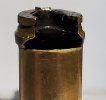
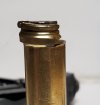
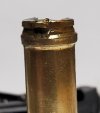
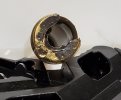
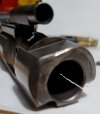
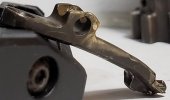
I think what we are seeing is: "a little of column A, a little of column B"
the brass failed at high pressure, but not a crazy amount of pressure. My quick load calculations show a 72k psi chamber pressure for a double load. So while it's not a crazy amount over pressure, it still is too much. Too much for the brass. I probably have reused this brass 3-4 times for moderate pressure loads in the 30k-40kpsi chamber pressure range.






CWLONGSHOT
Well-Known Member
Defineate evidence of case "issues" shown in the pics. But you also see the deep indentation of the extractor and NO "sweep". Thats tell tail timing thing of a large excessive pressure spike. You can also see how the brass flowed around the bolt itself!
Brass plays such a small place in retaining pressure. About only places it does is where this blow out occured.In unsupported areas of a hand gun and the web areas in many rifles. IMHO NOT AT ALL telling me of brass "failure" it is a atypical over pressure signature.
I have seen more then a few quite similar blow outs. From various calibers.
CW
Brass plays such a small place in retaining pressure. About only places it does is where this blow out occured.In unsupported areas of a hand gun and the web areas in many rifles. IMHO NOT AT ALL telling me of brass "failure" it is a atypical over pressure signature.
I have seen more then a few quite similar blow outs. From various calibers.
CW
Last edited:
Ian
Notorious member
the brass failed at high pressure, but not a crazy amount of pressure.
Really?
Let's take a little closer look. Your primer pocket is double the volume, the case head mushroomed, brass flowed fully into the extractor and ejector recesses, split your BCG, and the escaping pressure from the totally destroyed case head spread your upper. Hard case-head brass begins to flow somewhere around 65-70K psi.
The AR is a strong action and will contain "normal" case head separation or primer blowouts without much drama. What you have shows evidence of pressure well north of 100K psi. What Quickload cannot and does not predict is how powders designed for 12K psi can get STUPID with burn rate when subjected to high pressure. Blue Dot in particular is sketchy when taken out of its design parameters.
You got lucky this time. I'd abandon Blue Dot for future AR experiments.
RBHarter
West Central AR
72kpsi just vaporizes primers and opens pockets a little , at least in Mauser type actions with flat bolt faces . Been there in a Carcano because I didn't weigh a new to me bullet , and a 98 that decapitated a 22-250 due to heat . I'm glad the 6.8 wasn't in the AR ......
Dimner
Named Man
Well that sounds better. It did seem like alot of damage for something if it was only 70ish psi.Really?
Let's take a little closer look. Your primer pocket is double the volume, the case head mushroomed, brass flowed fully into the extractor and ejector recesses, split your BCG, and the escaping pressure from the totally destroyed case head spread your upper. Hard case-head brass begins to flow somewhere around 65-70K psi.
The AR is a strong action and will contain "normal" case head separation or primer blowouts without much drama. What you have shows evidence of pressure well north of 100K psi. What Quickload cannot and does not predict is how powders designed for 12K psi can get STUPID with burn rate when subjected to high pressure. Blue Dot in particular is sketchy when taken out of its design parameters.
You got lucky this time. I'd abandon Blue Dot for future AR experiments.
Live and learn
